Over 180,000 evacuate northern California amid dam flood threat
About 188,000 people near Oroville, Calif. were told to evacuate northern California on Sunday after a hole in the Oroville Dam's emergency spillway threatened major flooding in the area.
The Oroville Dam, the country's tallest dam reservoir reached capacity over the past week, and its main spillway was severely damaged, according to the Los Angeles Times. When dam operators reduced flows to the damaged main spillway, water reached the top of the untested emergency spillway for the first time in the dam's 48-year history, according to the Sacramento Bee. Storms and heavy snow prevented the operators from releasing enough water through the main spillway to prevent the reservoir waters from topping the emergency spillway's lip.
Spillways are safety valves designed to release water in a controlled manner to prevent water from flowing over the dam's lip, according to the Washington Post.
The National Weather Service announced Sunday that it expected the emergency spillway to fail just before 6:00 p.m. that day due to severe erosion, the Bee reports. That spillway's failing could have sent what the California Department of Water Resources called an "uncontrolled release of flood waters from Lake Oroville,” per CBS SF Bay Area.
An evacuation was ordered around 4:20 p.m. on Sunday, and was expanded to areas of Butte and Yuba Counties when the emergency spillway was expected to fail. Major arteries, minor arteries and highways leading out of the area to the north, south and west remained clogged through the night, the Post reports.
Meanwhile, state officials sent helicopters out to dump containers of boulders on the eroded area near the emergency spillway, according to the Bee. Water officials from the state nearly doubled the water releases through the dam's damaged main spillway from 55,000 cubic feet per second to 100,000 cubic feet per second.
California Governor Jerry Brown instated an emergency order to aid the state's response to evacuations and rectifying the dam's situation, the Post reports. The Federal Emergency Management Agency (FEMA) also sent an incident management team to the state office of emergency services.
By 4 a.m. Monday, the reservoir's level had dropped to below the lip, according to the Post. However, approaching storms and the damaged water infrastructure could yield more danger in the immediate future, per officials. As a result, residents remained unsure when they would be able to return to their homes. Butte County Sheriff Kory Honea will not lift the ban until water officials better understand the dam's related risks, the Post reports.
“I recognize how tough this situation is on people,” Honea told the Post. “I recognize that we’ve had to displace a lot of people.”
_____________
To get connected and stay up-to-date with similar content from American City & County:
Like us on Facebook
Follow us on Twitter
Watch us on YouTube





















Good to read!
Good to read!